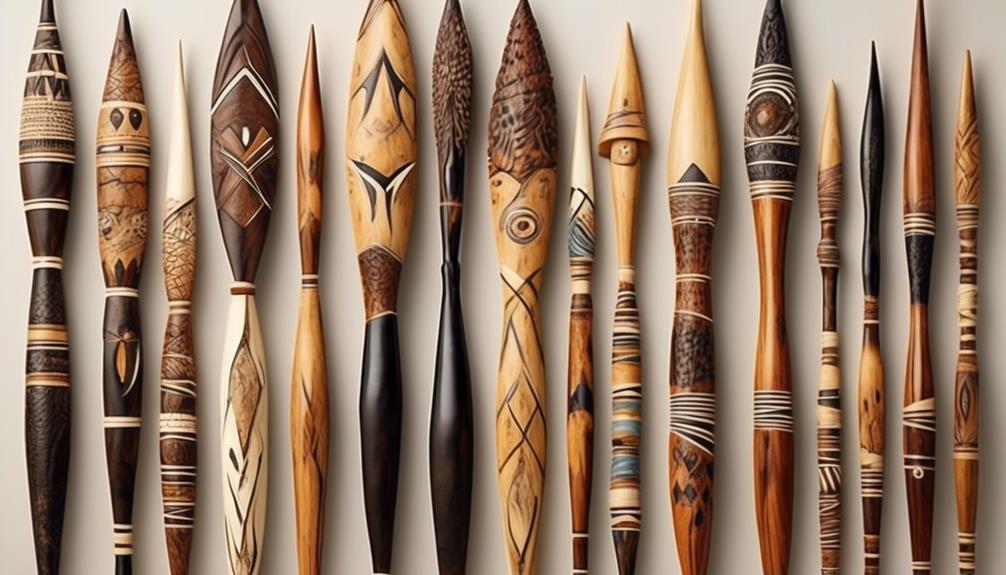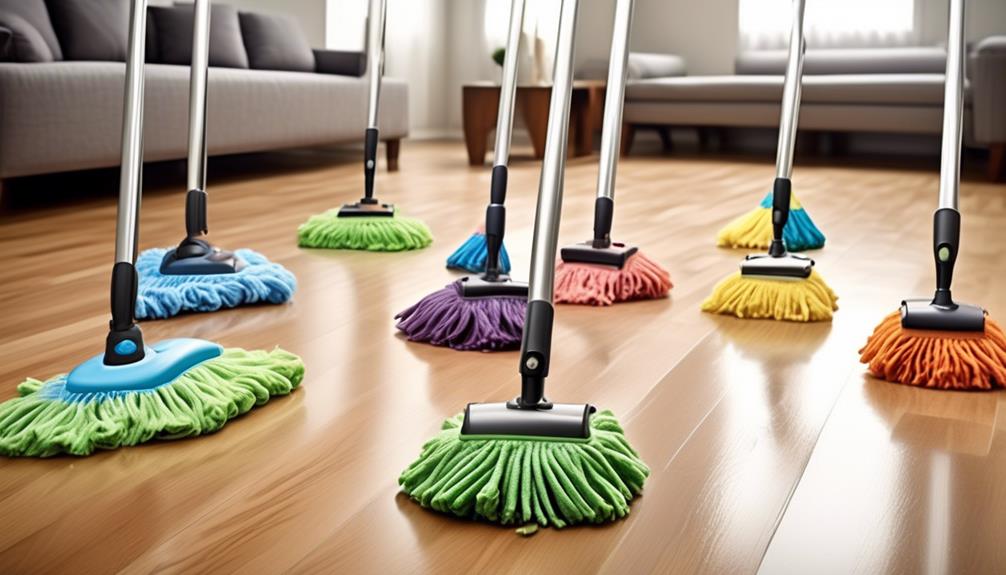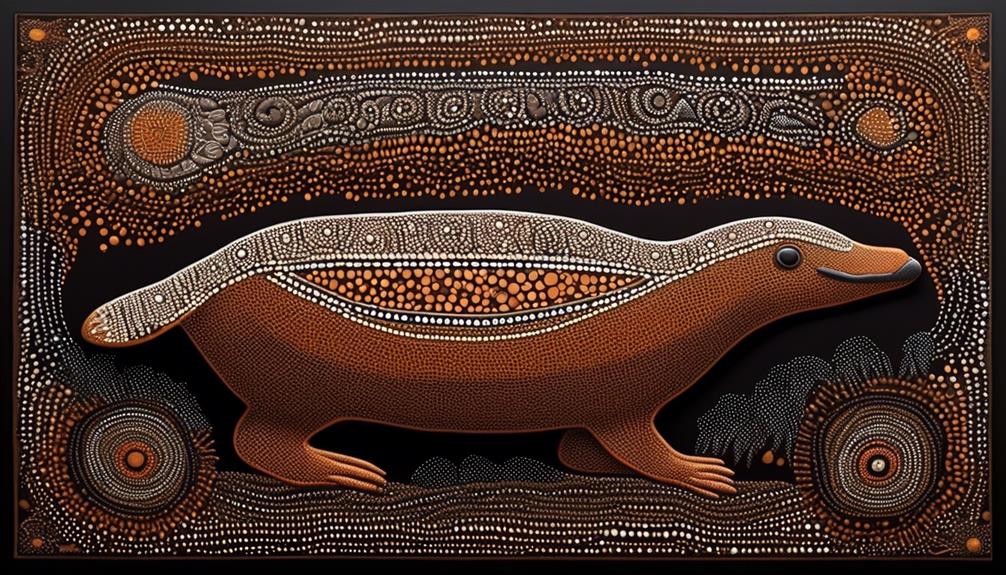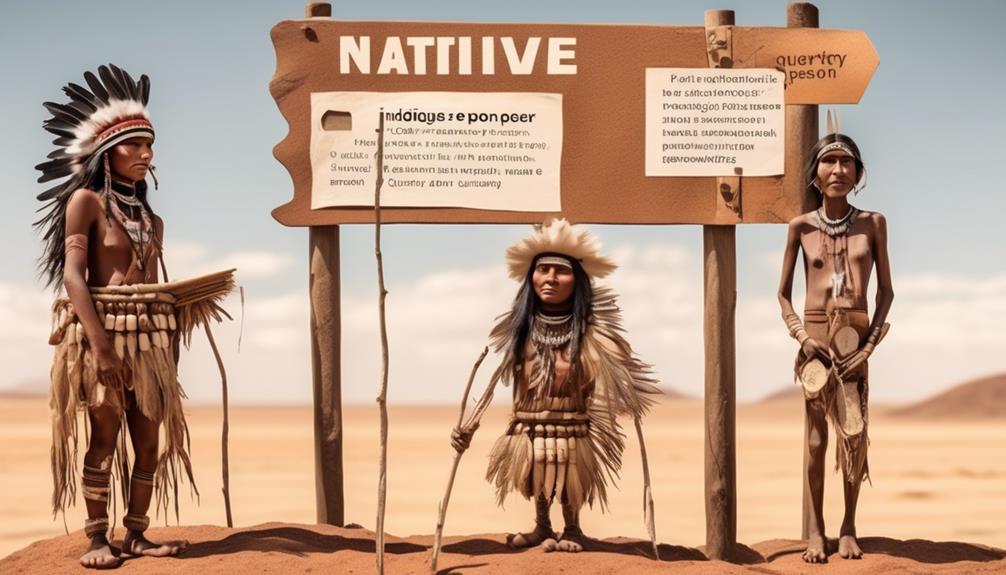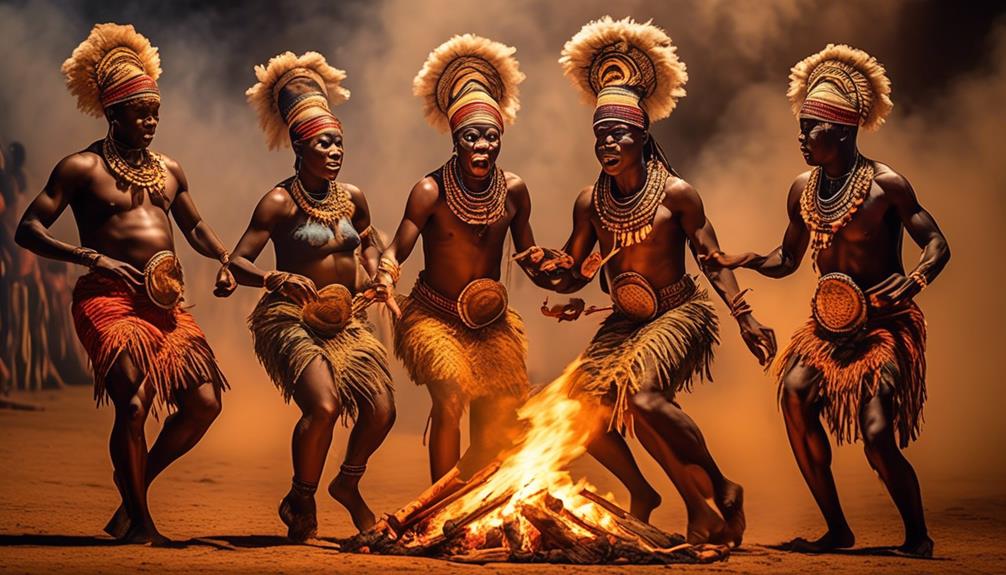Have you ever thought about the enduring elegance and intelligence of Indigenous spears?
As we explore the depths of indigenous cultures and their traditional practices, the art of crafting and utilizing these ancient tools unveils a rich tapestry of history and significance.
From the diverse array of spear types to the intricate construction methods passed down through generations, the world of Aboriginal spears offers a captivating glimpse into the depth of indigenous knowledge and the enduring legacy of their traditions.
Key Takeaways
- Aboriginal spears hold deep spiritual and cultural significance, representing a connection to land, history, and identity.
- Different types of spears, crafted from materials with cultural meaning, were used for hunting, fishing, and warfare.
- Spear construction techniques showcase artistry and resourcefulness, tailored to specific hunting environments and reflecting Indigenous traditions.
- The preservation and evolution of Aboriginal spear traditions involve the incorporation of contemporary practices, while still maintaining the ancient knowledge and expertise of Indigenous communities.
Origins of Aboriginal Spears
The origins of Aboriginal spears can be traced back thousands of years, reflecting the deep connection of Indigenous peoples to their land and culture. These spears hold immense historical significance, representing not only tools for hunting and survival but also embodying the spiritual and cultural essence of Aboriginal communities. The craftsmanship and design of these spears vary across different Aboriginal groups, showcasing the diversity and rich traditions of Indigenous cultures.
Historically, the creation of spears was a revered practice, often involving intricate rituals and ceremonies. The process of crafting a spear was a sacred art, passed down through generations, symbolizing the deep respect and connection to the land. The materials used, such as wood, stone, and animal parts, were carefully selected and imbued with cultural meaning, infusing the spears with spiritual significance.
These spears weren't merely weapons for hunting or warfare; they were a reflection of the intimate relationship between the Aboriginal people and their environment. The designs etched or painted onto the spears often depicted stories of creation, spiritual beliefs, and connections to ancestral lands. Each spear was a testament to the profound wisdom and traditional knowledge of the Aboriginal communities, encapsulating the resilience and enduring spirit of Indigenous peoples throughout history.
The origins of Aboriginal spears stand as a testament to the rich cultural tapestry of Indigenous communities, serving as a reminder of the deep-rooted connection to the land and the enduring legacy of Aboriginal traditions.
Varieties of Aboriginal Spears
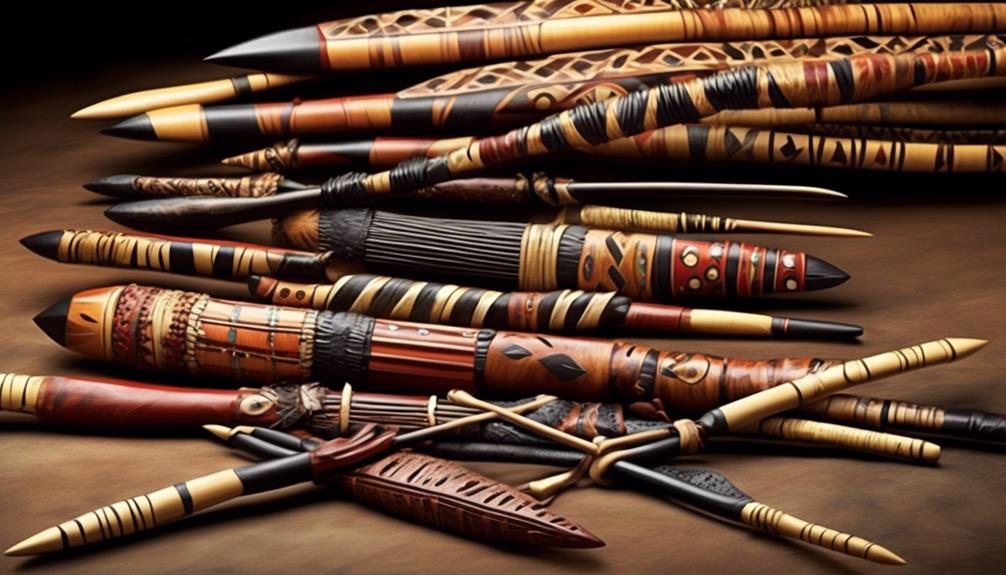
Now let's talk about the different types of Aboriginal spears.
The materials used to make them and their various uses.
We'll explore the unique characteristics of each type of spear.
The significance of the materials in spear construction.
And how these spears were utilized in Aboriginal culture.
This discussion will provide insight into the diverse and practical nature of Aboriginal spears.
Spear Types
Exploring the diverse range of Aboriginal spears reveals the ingenuity and adaptability of traditional hunting and warfare tools. When considering spear types, it's fascinating to delve into the varied techniques and strategies employed by Indigenous communities.
- Spear throwing techniques:
Skilled artisans meticulously crafted spears, incorporating intricate designs and vibrant colors, showcasing Indigenous spear artistry. The art of spear throwing, handed down through generations, reflects the precision and finesse of Aboriginal hunting traditions.
- Spear hunting strategies:
Spears were tailored to suit specific hunting environments, from dense forests to open plains, demonstrating the resourcefulness of Aboriginal spear making traditions. The strategic implementation of spears in hunting expeditions underscores the deep understanding of animal behavior and habitat navigation.
The multitude of spear types not only reflects the rich diversity of Aboriginal cultures but also exemplifies the symbiotic relationship between the land and its people.
Spear Materials
Crafted from a diverse array of materials, Aboriginal spears showcase the resourcefulness and adaptability of Indigenous craftsmanship. Spear design varies across different Aboriginal communities, with each group utilizing traditional techniques and local resources to fashion their spears.
In some regions, hardwood such as mulga or wattle is carefully selected for its strength and durability. Other communities fashion spears from bone or antler, harnessing the natural resilience of these materials. The process of crafting spears often involves intricate methods passed down through generations, ensuring that each spear is expertly designed to serve its purpose.
Spear Uses
Utilizing a wide range of designs and materials, Aboriginal communities have developed various types of spears tailored to specific hunting, fishing, and warfare needs. These spears aren't only practical tools but also hold deep ceremonial significance within the community.
When it comes to spear throwing, the Barbed Spear stands out, with its intricate barbs designed to increase the chances of a successful hunt. On the other hand, the Fishing Spear features a forked tip, allowing for efficient capture of aquatic creatures while minimizing damage to the catch.
Each of these spears is carefully crafted to serve its purpose, reflecting the deep connection between the Aboriginal people and the land. This connection is further reinforced through the ceremonial use of these spears, symbolizing the harmony between the community and the natural world.
Traditional Spear Construction
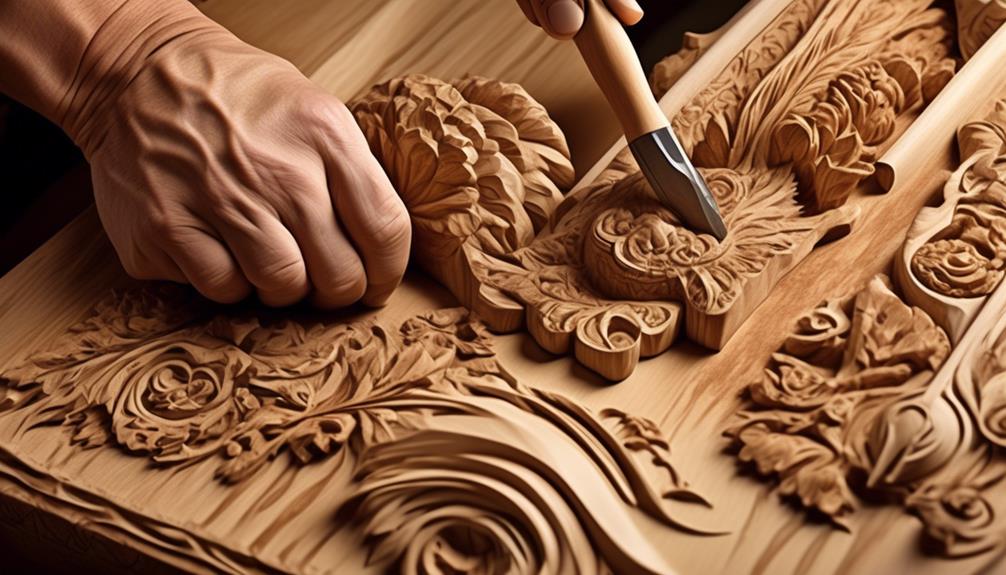
How were traditional Aboriginal spears constructed to ensure effectiveness in hunting and warfare? Traditional spear construction was a vital aspect of Aboriginal culture, utilizing traditional techniques that were passed down through generations. The cultural significance of spear construction went beyond mere functionality, as it was deeply intertwined with spiritual beliefs and the connection to the land.
| Traditional Techniques | Cultural Significance |
|---|---|
| Selecting the right wood | Connection to the land |
| Crafting the spearhead | Spiritual significance |
| Decorating the spear | Cultural identity |
The construction of traditional Aboriginal spears involved selecting the right wood, often from trees like mulga or black wattle, which were known for their strength and flexibility. Crafting the spearhead was a meticulous process, usually done using a combination of controlled burning and shaping with stone tools. The spearhead was not only a practical hunting tool but also held spiritual significance, often adorned with intricate carvings or designs that reflected the cultural identity of the maker. Decorating the spear was another important step, as it served as a way to honor the animal being hunted and to express gratitude for the resources provided by the land.
Significance in Indigenous Culture
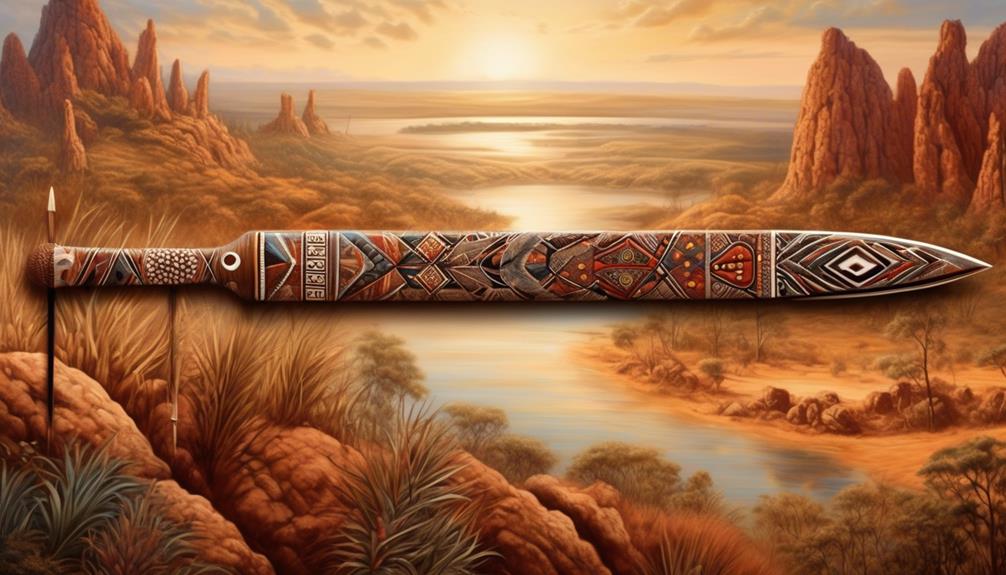
Exploring the significance of traditional Aboriginal spears in Indigenous culture reveals a rich tapestry of spiritual, practical, and communal importance. These spears aren't merely tools for hunting or warfare; they hold deep spiritual significance, connecting us to our ancestors and the land. The act of crafting a spear is a sacred tradition, passed down through generations, and each spear carries the spirit of the maker within it. When we hold a spear, we're holding a piece of our history, our identity, and our connection to the natural world.
The spiritual significance of spears is woven into every aspect of their creation, from the selection of materials to the intricate designs adorning them. The process of making a spear is a meditation, a spiritual journey that connects us to the land and the spirits of our ancestors. The finished spear becomes a conduit for our prayers, a symbol of our connection to the earth and the creatures that sustain us.
Moreover, as our culture faces ongoing threats, preservation efforts are crucial to ensure that the spiritual significance of these spears endures. These efforts go beyond mere conservation; they're a testament to our resilience and our determination to protect our heritage for future generations. The preservation of traditional spear-making techniques and the stories behind them is a vital part of our ongoing fight for cultural autonomy and self-determination.
Hunting and Fishing Techniques

Weaving together age-old wisdom and practical knowledge, our hunting and fishing techniques are deeply rooted in the land and the rhythms of nature. Our traditional techniques have been passed down through generations, shaped by our deep connection to the environment and our respect for all living beings. Sustainability practices are at the heart of our approach, ensuring that we take only what we need and honor the delicate balance of the ecosystem.
| Traditional Techniques | Sustainability Practices | Importance of Preservation |
|---|---|---|
| Tracking and Trapping | Seasonal Harvesting | Regulating Catch Sizes |
| Spearfishing | Avoiding Overfishing | Protecting Breeding Areas |
| Net Making | Selective Hunting | Supporting Habitat Restoration |
| Gathering Techniques | Avoiding Wasteful Practices | Promoting Wildlife Conservation |
Our traditional techniques encompass a range of skills and knowledge, from tracking and trapping to spearfishing and net making. These methods have evolved over centuries, allowing us to sustainably harvest from the land and waters. By adhering to sustainability practices such as seasonal harvesting and avoiding overfishing, we ensure the continued abundance of resources for future generations. Equally important is the preservation of ecosystems, which is why we regulate catch sizes, protect breeding areas, and support habitat restoration. Our commitment to these practices reflects our reverence for nature and our deep understanding of the interconnectedness of all life. Through our hunting and fishing techniques, we not only sustain ourselves but also contribute to the flourishing of the natural world.
Warfare and Defensive Use
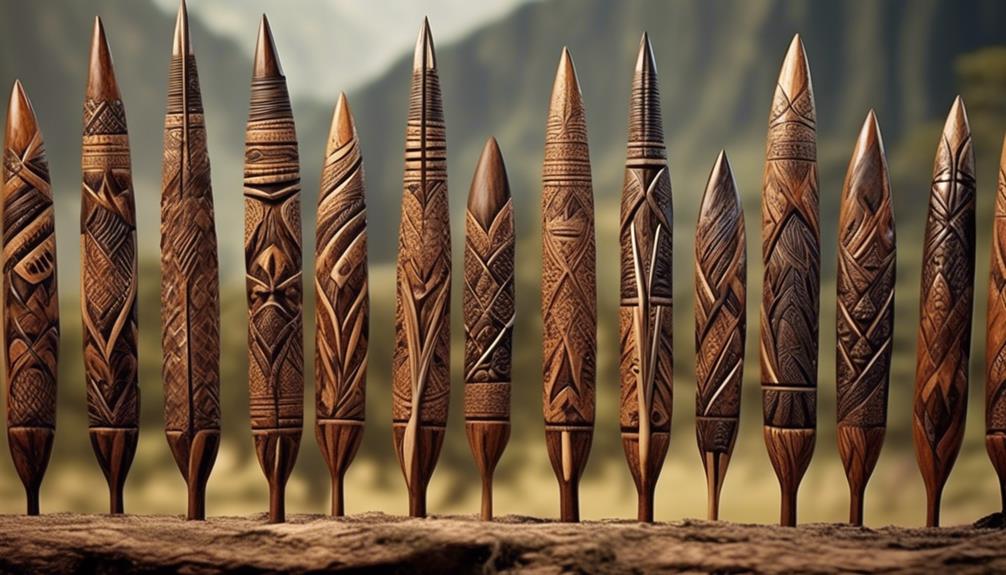
Alright, let's talk about how Aboriginal spears were utilized in warfare and for defensive purposes.
The spear wasn't only a tool for hunting but also a formidable weapon in battles.
We'll explore the defensive tactics and strategies employed by Aboriginal communities to protect themselves using spears.
Spear as Weapon
How did the Aboriginal people use spears as a means of warfare and defense?
The construction of our spears wasn't merely a physical process; it was interwoven with spiritual connections to our land and ancestors. When we prepared for warfare, the act of crafting a spear became a sacred ritual, infusing each weapon with the strength and protection of our ancestors.
In battle, our spears became extensions of ourselves, guided by our fierce determination to defend our land and people. As we hurled our spears towards our enemies, the air would hum with the power of our ancestors, propelling our weapons with unyielding force and accuracy.
Our spears weren't just tools of war; they were embodiments of our resilience and unwavering spirit.
Defensive Tactics
In defensive tactics, we strategically positioned ourselves to protect our land and people using the sacredly crafted spears as extensions of our unwavering spirit and determination.
Our defensive tactics were rooted in our survival skills, honed over generations, and passed down through our ancestral wisdom.
We learned to use the terrain to our advantage, utilizing natural barriers and hidden pathways to outmaneuver our adversaries.
Our spears weren't just tools for physical defense, but symbols of our resilience and unity.
Through our defensive tactics, we upheld our sovereignty and safeguarded our way of life.
Our people's liberation depended on our ability to defend ourselves, and our mastery of defensive tactics allowed us to stand strong against any threat to our existence.
Symbolism and Spiritual Connections
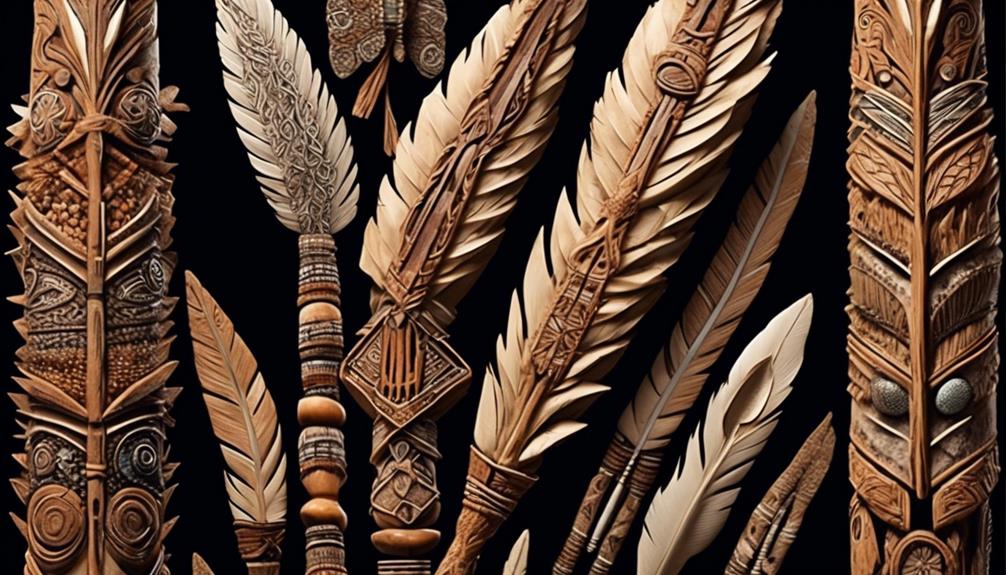
Symbolism and spiritual connections play a significant role in the cultural significance of Aboriginal spears, enriching the traditional practices and beliefs of the indigenous communities.
- Symbolic representations
- The intricate designs adorning the spears often depict ancestral stories, creation myths, and the interconnectedness of all living beings. These symbols serve as a visual language, carrying the wisdom and knowledge of the elders through generations.
- The materials used to craft the spears, such as native woods and natural pigments, hold symbolic meanings. The selection and preparation of these materials are imbued with spiritual significance, reflecting the deep respect for the land and its resources.
In Aboriginal culture, the spears aren't merely tools for hunting or warfare; they're embodiments of spiritual connections and profound symbolism. The act of crafting a spear involves a spiritual journey, connecting the maker to the ancestral spirits and the natural world. Each symbol intricately carved into the spear carries layers of meaning, evoking a sense of unity with the spiritual realm and the land.
As a community, we must recognize and respect the spiritual significance and symbolic representations associated with Aboriginal spears, understanding that they aren't just objects, but sacred expressions of cultural heritage and spiritual wisdom.
Cultural Importance Today

The spiritual connections and symbolic representations deeply embedded in Aboriginal spears continue to resonate in their cultural importance today, shaping their significance in contemporary Indigenous communities. The traditional significance of spears has undergone cultural adaptation to maintain its contemporary relevance. In today's context, Aboriginal spears aren't only seen as tools for hunting or fighting but also as symbols of resilience, strength, and cultural identity. They serve as a connection to the past, a reminder of the ancestral knowledge and survival skills that have been passed down through generations.
The cultural importance of Aboriginal spears today extends beyond their practical utility. They're revered as artifacts that embody the history and traditions of Indigenous peoples. Their presence in ceremonies, artwork, and storytelling demonstrates their enduring value in preserving and expressing cultural heritage. Furthermore, the symbolic meaning attached to spears has evolved to encompass themes of resistance, empowerment, and cultural revitalization.
In a rapidly changing world, the contemporary relevance of Aboriginal spears lies in their ability to bridge the gap between the past and the present. They aren't just relics of a bygone era but living symbols of resilience and adaptation. As Indigenous communities navigate modern challenges, the cultural importance of spears serves as a source of strength and inspiration, reminding them of their ancestors' enduring legacy and the ongoing fight for cultural recognition and liberation.
Regional Differences in Spear Usage
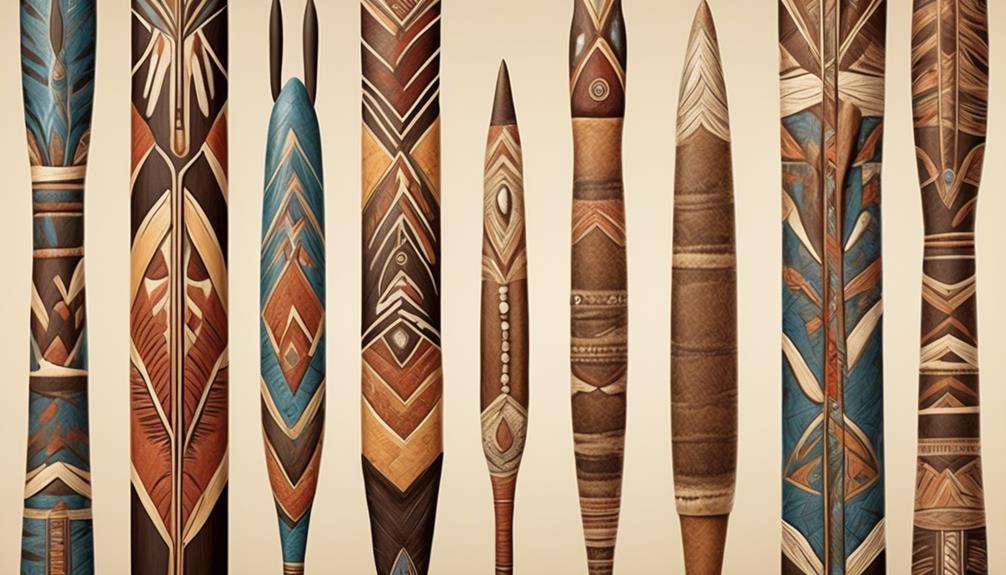
Surprisingly, regional differences in spear usage among Aboriginal communities reveal diverse approaches to hunting and cultural practices. Regional variations in spear design and application reflect the unique landscapes and available resources in different areas.
In coastal regions, where fishing is a significant part of the culture and diet, spears are often designed with barbed tips to effectively catch fish, showcasing the cultural significance of marine life. On the other hand, in arid inland areas, spears are crafted with longer, sturdy shafts for hunting larger land animals, emphasizing the cultural significance of the connection to the land and the creatures that inhabit it.
The traditional techniques used in spear hunting have evolved to incorporate contemporary practices while still maintaining cultural significance. In some regions, traditional spear-making methods have been preserved and passed down through generations, symbolizing the preservation of cultural heritage. However, in urban settings, Aboriginal communities have adapted spear usage for contemporary activities such as sports and ceremonial performances, demonstrating the flexibility of cultural practices in modern contexts.
The regional differences in spear usage highlight the diverse ways in which Aboriginal communities have adapted their hunting methods to suit their environments and cultural traditions. These variations not only showcase the rich tapestry of Aboriginal cultures but also emphasize the ongoing importance of traditional knowledge and practices in contemporary society.
Indigenous Spear-making Techniques
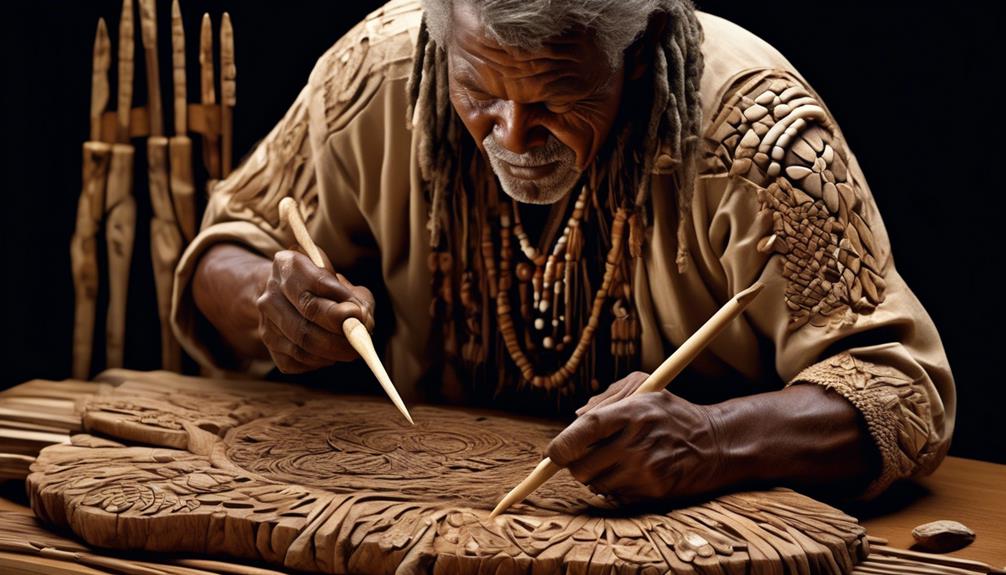
Indigenous communities across various regions have honed distinct spear-making techniques, reflecting their deep connection to the natural world and the specific hunting needs of their environments. The Indigenous craftsmanship involved in spear-making is a testament to the deep knowledge and understanding of the land and its resources.
Traditional techniques for crafting spears vary among different Indigenous communities, with each group utilizing materials readily available in their surroundings. For instance, some communities use hardwood like ironwood or blackwood for spear shafts, while others may prefer bamboo or river reeds. The choice of materials is often informed by their strength, flexibility, and availability in the local ecosystem.
Furthermore, the process of crafting spearheads is an art form in itself. Indigenous peoples employ various techniques such as heat-treating and shaping to fashion spear tips from materials like bone, stone, or metal. The craftsmanship involved in creating these spearheads showcases the ingenuity and skill of Indigenous artisans. Additionally, the design of the spearhead is often tailored to the specific prey targeted for hunting, with different shapes and sizes optimized for various hunting purposes.
These traditional techniques are passed down through generations, preserving ancient knowledge and expertise. The art of spear-making not only serves practical hunting needs but also embodies a spiritual and cultural connection to the land, making it a deeply significant aspect of Indigenous heritage.
Rituals and Ceremonies
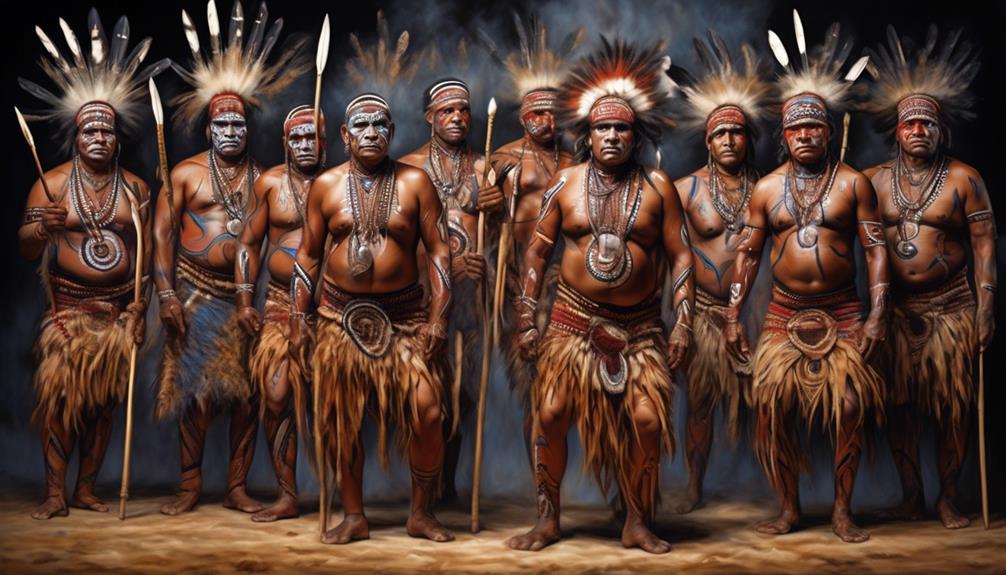
Having explored the intricate craftsmanship of spear-making in Indigenous communities, our focus now shifts to the rich tapestry of rituals and ceremonies that embody the spiritual and cultural significance of these traditional practices.
In Aboriginal cultures, ritual practices and ceremonial significance are woven deeply into the fabric of daily life, connecting individuals to their ancestors, the land, and the spiritual realm.
- Dance and Song
- The rhythmic beat of the didgeridoo, accompanied by the haunting melodies of clapsticks, fills the air as dancers adorned in vibrant ochre paint move with purpose and grace. Their movements tell ancient stories, invoking the spirits of the land and ancestors, and creating a powerful connection between the physical and spiritual worlds.
- The songs sung during these ceremonies carry the weight of generations, their lyrics echoing the wisdom and knowledge of the elders. As the voices rise and fall in harmony, they weave a tapestry of sound that binds the community together, uniting them in a shared experience of cultural identity and belonging.
In these rituals and ceremonies, the act of spear-making becomes more than just a practical skill; it becomes a sacred art form, a means of honoring tradition and connecting with the spiritual essence of the natural world. The significance of these practices extends far beyond the physical act of creating a tool for hunting; it's a profound expression of cultural heritage and a testament to the enduring strength of Indigenous traditions.
Evolution of Spear Designs
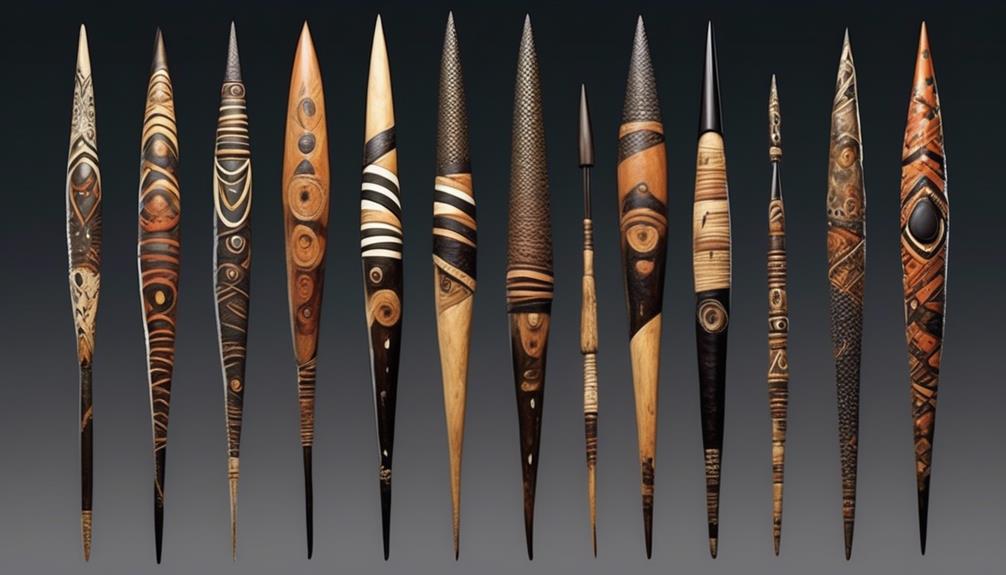
The evolution of spear designs reflects the dynamic adaptation of Indigenous communities to diverse environmental landscapes and changing hunting techniques. Throughout history, Indigenous peoples have innovated and refined spear designs to suit the specific needs of their environment and hunting practices. These evolutionary adaptations are a testament to the deep understanding and intimate connection that Indigenous communities have with their surroundings.
Spear designs haven't only been functional hunting tools but have also held immense cultural significance within Indigenous communities. The intricate carvings, engravings, and decorations on spears often conveyed stories, traditions, and spiritual beliefs. As spear designs evolved, they continued to serve as a canvas for artistic expression and cultural preservation.
The cultural significance of spear designs extended beyond mere functionality. They were often imbued with spiritual meanings and played pivotal roles in rituals and ceremonies. The evolution of spear designs mirrored the evolution of Indigenous societies, representing their resilience, creativity, and adaptability.
Furthermore, the evolution of spear designs highlights the sustainable practices of Indigenous communities. By creating spears that were tailored to specific prey and environments, Indigenous peoples demonstrated a deep respect for the natural world and a commitment to sustainable hunting practices.
Preservation of Indigenous Knowledge
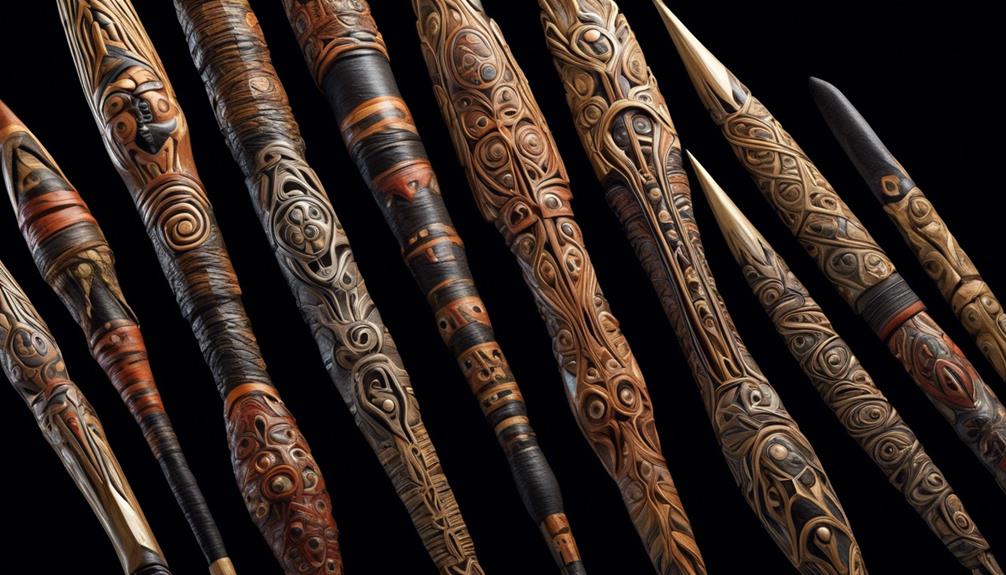
As we examine the significance of preserving indigenous knowledge, we recognize the vital role it plays in safeguarding cultural heritage.
Indigenous knowledge isn't only valuable for the communities it belongs to but also for the broader understanding of diverse traditions and practices.
Our focus on the transmission of this knowledge is crucial for ensuring its continuity and relevance in the modern world.
Cultural Heritage Preservation
Preserving indigenous knowledge is crucial for maintaining the cultural heritage of Aboriginal communities. It's vital to employ preservation methods that respect the cultural significance of traditional practices.
- By recording oral histories, we ensure that valuable knowledge is passed down through generations, safeguarding the essence of our culture. This allows for the preservation of stories, language, and customs that hold profound significance within our community.
- Through the documentation of traditional ecological knowledge, we protect valuable insights into sustainable land management and resource use. This empowers future generations to continue practicing age-old traditions that are deeply interwoven with our cultural identity.
Indigenous Knowledge Transmission
Employing modern technologies alongside traditional methods allows us to ensure the continued transmission of indigenous knowledge to future generations.
Oral storytelling, a cornerstone of cultural transmission, remains a vital tool for passing down traditional knowledge. Through intergenerational learning, our communities foster an environment where elders impart their wisdom to the youth, ensuring the preservation of our heritage.
Embracing modern advancements, such as digital storytelling platforms and interactive media, enhances our ability to capture and disseminate traditional knowledge. These technologies enable us to document and share our stories, rituals, and practices, safeguarding them for the upcoming generations.
Spear Use in Modern Times

Aboriginal communities continue to utilize spears for hunting, fishing, and cultural ceremonies in modern times. Our spear throwing techniques have been passed down through generations, ensuring that we maintain our traditional hunting practices while also adapting to modern needs.
In contemporary society, we continue to honor our ancestors by incorporating modern adaptations to our spear usage, allowing us to sustain our way of life while embracing the present.
- When we hunt, we employ spear throwing techniques that have been refined over centuries. The fluid motion of our bodies, combined with the precise release of the spear, allows us to accurately target our prey, ensuring a respectful and efficient hunt.
- As we adapt to modern times, we've integrated new materials and designs into our spears, enhancing their durability and accuracy. This modernization enables us to maintain our customs while meeting the demands of today's world.
Our connection to the land and water is deeply intertwined with the use of spears for fishing. The skillful application of spear throwing techniques allows us to sustainably harvest fish, respecting the delicate balance of aquatic ecosystems. By incorporating modern adaptations, such as improved spear tips and handles, we ensure that our fishing practices remain effective and in harmony with our environment.
This fusion of tradition and innovation exemplifies our commitment to preserving our cultural heritage while embracing the opportunities of the present day.
Future of Aboriginal Spear Traditions
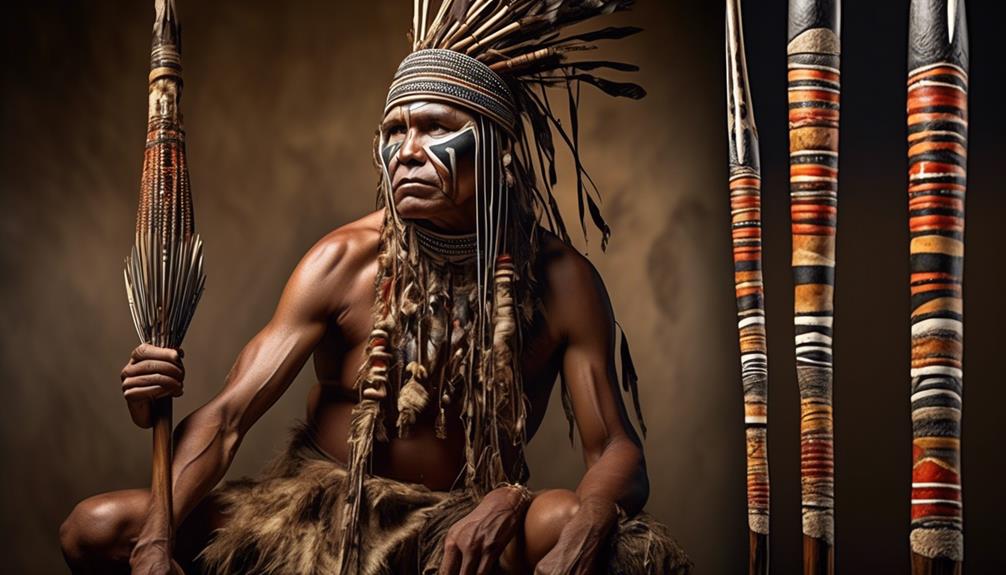
Our ongoing commitment to incorporating modern adaptations into our spear usage ensures the preservation of our cultural heritage while sustaining our traditional hunting and fishing practices in the future. As custodians of our ancestral knowledge, we recognize the importance of adapting to the changing world while safeguarding our traditions. The future preservation of Aboriginal spear traditions relies on our ability to embrace innovation without compromising the essence of our cultural transmission.
Embracing the future entails amalgamating time-honored techniques with contemporary advancements. By infusing our spear-making processes with modern tools and materials, we can enhance the durability and effectiveness of our traditional hunting and fishing practices. This evolution ensures that our cultural heritage remains relevant and accessible to future generations. Moreover, by combining age-old wisdom with modern insights, we fortify the resilience of our traditions in the face of evolving environmental and societal dynamics.
Cultural transmission lies at the heart of our commitment to the future of Aboriginal spear traditions. As we look ahead, it's essential to impart our knowledge to younger members of our community, equipping them with the skills to carry our traditions forward. Through mentorship and hands-on experience, we ensure that the art of spear-making and the associated hunting and fishing techniques remain ingrained in our cultural fabric. Our dedication to preserving these traditions ensures that our heritage endures, serving as a testament to our resilience and adaptability.
Frequently Asked Questions
How Have Modern Technologies and Materials Influenced the Traditional Construction of Aboriginal Spears?
Modern materials and technology have greatly influenced traditional construction techniques. Spear construction now involves innovative materials and methods, enhancing the effectiveness and durability of the weapon.
These changes have revolutionized the way we approach traditional practices, allowing for more efficient and versatile construction processes.
The integration of modern technologies has expanded the possibilities within traditional crafts, empowering us to create tools that are both rooted in tradition and adapted for contemporary needs.
What Are the Specific Rituals and Ceremonies Associated With the Making and Use of Aboriginal Spears in Different Indigenous Communities?
In different indigenous communities, cultural ceremonies hold a significant place, representing spiritual connections and traditions. These ceremonies are deeply rooted in the beliefs and practices of the community, serving as a way to honor ancestors and connect with the spiritual world.
Through these rituals, the community reaffirms its identity and values, fostering a sense of unity and pride. The making and use of aboriginal spears are often intertwined with these meaningful cultural ceremonies, reflecting the profound significance of these traditions.
How Has the Evolution of Spear Designs Impacted the Cultural Significance and Spiritual Connections of Aboriginal Spears?
We've observed that the evolution of spear designs has had a profound impact on the cultural significance and spiritual connections of many indigenous communities.
As designs have evolved, so too have the ways in which these spears are integrated into rituals and ceremonies.
This evolution has allowed for a continued deepening of spiritual connections and cultural significance, as the spears become more than just tools, but symbols of heritage and tradition.
What Efforts Are Being Made to Preserve and Pass on Indigenous Knowledge Related to Spear-Making and Usage?
Well, let me tell you, we're all about preserving traditions and passing on knowledge when it comes to indigenous education.
It's crucial to ensure that cultural significance is maintained and that the wisdom of our ancestors isn't lost.
We're making efforts to ensure that the traditional ways of spear-making and usage are kept alive for future generations.
It's all about honoring our heritage and keeping our traditions alive.
In What Ways Are Aboriginal Spears Still Utilized in Modern Times, Beyond Traditional Hunting and Warfare?
In modern times, we see aboriginal spears utilized in various ways beyond traditional hunting and warfare. These spears are used in cultural ceremonies, artistic expression, and as a means of connecting with and preserving indigenous traditions.
Conservation efforts play a crucial role in ensuring that these practices continue to thrive, honoring the deep-rooted significance of aboriginal spears in indigenous communities.
Conclusion
In conclusion, Aboriginal spears are more than just tools for hunting and fishing. They represent a rich cultural heritage and connection to the land.
Just like the versatile spear, Indigenous knowledge and traditions continue to adapt and thrive in the modern world.
As my grandfather used to say, 'Like the spear, our culture is sharp and strong, always ready to pierce through the challenges of today and tomorrow.'
And continue to uphold our connection to the land and our ancestors.
Talise is a talented writer and an expert in her field. Her unique perspective and insights enrich our content with depth and authenticity. With a wealth of knowledge and a strong connection to the subjects she writes about, Talise crafts engaging and informative articles that resonate with our readers. Her dedication to bringing Indigenous culture and wisdom to light is truly commendable.
